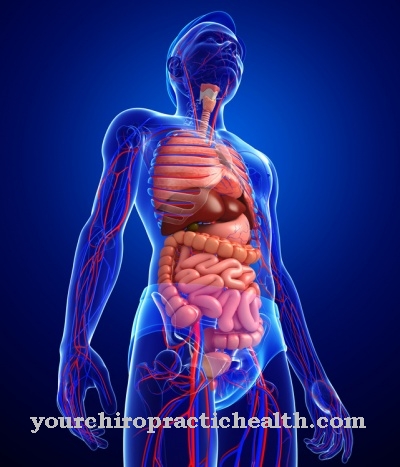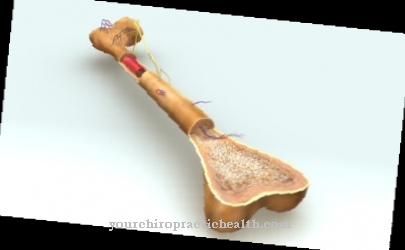The Stereognosia is the ability to recognize objects on the basis of mere tactile experience. In addition to the individual components of the sense of touch, the post-central region of the parietal lobe is primarily involved in this ability. Lesions in these regions can interfere with this ability and cause a so-called astereognosia (stereoagnosia).
What is stereognosis?

The post-central brain areas of the parietal lobe play a crucial role for the human sense of touch. The ability to recognize shapes and consistencies through tactile processes is based on these sections of the brain and to assign the felt object to a certain object based on its specific properties. These skills are summarized under the term stereognosy.
Stereoagnosia depends on the one hand on the intact structures of the sense of touch and on the other hand on the individual's ability to interpret. The absolute inability to recognize objects by means of tactile processes is called stereoagnosis in medicine. Stereoesthesia is to be distinguished from stereognosia. This ability is a basic requirement for stereognosy, but it is not to be regarded as a synonym for it. Stereoesthesia is based on a combination of epicritical sensitivity and deep sensitivity and is one of the most complex qualities of tactile sensitivity. A failure of this ability is called stereo anesthesia and automatically results in a simultaneous stereo diagnosis.
Function & task
The perception by actively touching certain objects is called haptics. Together with tactile perception, it forms the totality of the sense of touch, the biophysiological basis of which is the somatosensory system and the sensorimotor system.
Stereognosia is a quality of haptic perception. Different receptors are involved in every haptic perception, especially the mechanoreceptors. They are sensitive to stretching, pressure and vibration stimuli and are estimated to have a number of up to 600 million within the skin layers. The most common mechanoreceptors are the Vater Pacini corpuscles for vibration stimuli up to 300 Hz, the Meissner corpuscles for pressure changes, the Merkel cells for sustained pressure stimuli and the Ruffini corpuscles for tissue stretching. The human body hair is also equipped with such touch sensors. These sensors are completed by the touch-sensitive nerve endings in the upper layer of the skin.
Unlike other sensory perceptions, haptic perception depends on the integration of multiple information from different receptors. The density of receptors at the fingertips is extremely high and is therefore particularly crucial for stereognosia. The information from the individual receptors travels via afferent sensory nerve pathways into the spinal cord and reaches the cerebral cortex via the thalamus. Within the thalamus, the information is interconnected in the nucleus ventralis posterior. The resident neurons project into the secondary and primary somatosensory areas.
The cortical processing continues via afferents to the parietal lobe. Its posterior regions in Brodmann areas 5 and 7 are particularly important for stereognosis. The somatosensory regions and the temporal parietal areas 22, 37, 39 and 40 also play a role. The same is true of the insula and the temporal or frontal association cortices. The multisensory integration is primarily carried out by the neurons in the posterior parietal cortex. These areas decide on all cognition that takes place on the basis of the perceptions. The connections to the insula help to assign shape information to an object and control affective components. In the temporal lobe, memory processes take place on the basis of previous tactile experiences, which help in object recognition.
The stereognosis depends on the one hand on the integrity of the structures described and on the other hand is influenced by association chains and stored tactile experiences in the respective brain areas.
Illnesses & ailments
Stereoagnosis can arise from brain lesions or damage to the afferent nerve tract. The same applies to stereoesthesia and the resulting stereoagnosis. Brain lesions in the areas described can be caused by a stroke, for example. Inflammatory lesions are also possible causes. The same applies to tumors or traumatic injuries such as traumatic brain injury.
Stereoagnosia can manifest itself in different ways. If, for example, afferent pathways are damaged, the tactile information no longer reaches the brain at all and can therefore not be used for object recognition. Even if the tactile information reaches the brain, it does not necessarily lead to object recognition. If, for example, the memory for tactile information is affected by lesions, the patient can no longer classify the object in spite of the object properties perceived when tactile, since he lacks the frame of reference for this. In this case, the forwarding and processing of the information is intact, but the ability to interpret it is lacking. Problems with multi-sensory integration can also favor stereoagnosis. According to the current state of knowledge, such integration disorders can have a genetic component and thus be innate.
The neurological disease multiple sclerosis is also often associated with a stereo diagnosis. The disease is an autoimmune disease. The immune system identifies the body's own nerve tissue in the central nervous system as a danger and attacks it. The antibodies cause inflammation in the brain or spinal cord and can thus also meet the conductive pathways for sensory information. They can also cause inflammation in processing-related brain areas such as the post-central brain areas of the parietal lobe and thus damage the basis for stereognosis. Depending on where exactly the inflammation is located, the destruction of central nervous tissue caused in this way can manifest itself as various types of stereoagnosis.
All types of stereoagnosis have one thing in common: Objects can no longer be recognized with closed eyes on the basis of mere tactile experience.
























.jpg)



